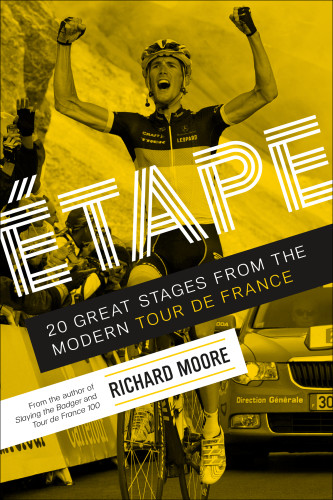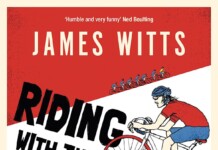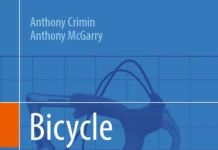
Contrary to what you may assume from its title, this is not a book about 20 of the greatest stages from the modern Tour. Rather, as it specifically states, these are stories. Yes, these stories arise from Tour stages, and his narrative of each stage is exciting. But these stories are more than that. Moore’s stories tell of individuals and events, and provide you with important background information, with facts and perspectives from the protagonists themselves, to create 20 very compelling tales.
In his introduction, Moore states that the 20 stories selected for this book “encompass extraordinary feats and diabolical deeds, heroism and deceit, farce and tragedy. … There were mysteries to investigate and myths to debunk–the feud between two team directors that distorted the outcome of a stage in 1992; a rest day disqualification in 1991; the untold stories of the grupetto; and some classics: l’Alpe d’Huez in 1984, Paris in 1989, Sestriere in 1992, Les Deux Alpes in 1998.” Just reading the introduction excited me: These were mostly stages and events that I had followed and could recall beginning with when I first started watching the Tour in 1984.
There is much to appreciate about this book. First, I was pleased Moore specifically defined and limited his book to the “modern” Tour. I am wary, and cynical, about lists and books claiming to encompass the 20 (or 50, 100, whatever number one chooses) greatest of whatever the topic is. I remember reading an article purporting to list the greatest professional cyclists, of which at least 75% were selected from the previous 25 years. No surprise. Those were the years the author was most familiar with, and for which he could find plentiful information. Moore makes no such claim. These are “great” stories, and they are mostly from the period of time with which he is personally familiar.
Second, he is not exclusionary. He includes stories from 1998 through 2012, the aptly named “doping era”, including chapters on Lance Armstrong, Marco Pantani, Jan Ulrich and other known dopers. He willingly acknowledges these stages and events occurred. He writes, while quoting Armstrong, “‘Those Tours happened,” he [Armstrong] said, “despite what a bunch of dickheads say.” Of course, you might disagree . . .”
I don’t. They most certainly did happen, though doping unquestionably changed the parameters of the competition. Nevertheless, these athletes trained hard and, particularly evident in Armstrong’s case, brought a calculating intelligence and hard discipline to their racing. There are some great stories to be told from this era. I have little respect for Armstrong as a person, but I can’t help but admire him as an athlete and a professional cyclist. He was a cheat, as were all other contenders of that era. But as Iban Mayo said of Armstrong, whom Armstrong called a punk, “I lived with him–no one can take that away. … But the difference between Armstrong and the rest of us was enormous. He was way superior to the rest.”
This sentiment is seconded by American Bobby Julich. Considered by some as Greg LeMond’s potential heir, Julich found himself while still a “hotshot junior” paired in a 2-man time trial with “this triathlon kid, Lance Armstrong . . . We did this five-minute effort, I was good for two minutes, then I was on the absolute rivet for the final three minutes. . . . Right then and there I said to myself, ‘Man, if there are more guys like that in the world, I don’t have a career.’ Because he was the strongest guy I had ever seen.”
Finally, Moore is a consummate story teller. Start reading a chapter and you will not put it down until it is finished. His is a writing style that is comfortable and compelling, a style that is a pleasure to read no matter what the topic might be.
Several chapters really stood out to me. The first, which is the last chapter of the book, is the story of Greg Lemond’s final stage time trial victory on the Champs-Elysées where he took back 58 seconds from Laurent Fignon over 15.2 miles to win the Tour by 8 seconds. On that day, he set the record for the fastest time trial over 10 kilometers in Tour history, 33.893 mph, a record which officially still stands. (Note: This record was broken by Utahn David Zabriskie on the opening day of the 2005 Tour, but he was later stripped of that victory after admitting that he doped.) Of his victory over Fignon that day, LeMond says, “I knew he was disappointed. What could I say to him? What could he say to me? I would have been devastated.” Interestingly, on the day he won the Tour, he had yet to be paid a single franc on his contract with ADR.
Then there is the chapter centered on stage 18 from the 1998 Tour. Moore refers to the 1998 Tour as “The strangest-ever Tour”, and borrowing a phrase from Dickens’ A Tale of Two Cities says “It was the best of Tours, it was the worst of Tours.” This was the year of the infamous Festina Affair when Willie Voet of the Festina team was caught crossing the French border with a boatload of banned drugs. Festina was ousted from the Tour, and the remainder of the Tour saw team hotels being raided by French police searching for banned drugs.
Still, the race went on. Jan Ulrich, who had won the Tour in 1997, was in the yellow jersey. Bobby Julich was tied for second with Laurent Jalabert, and Marco Pantani was a distant 4th, three minutes behind Ulrich. Stage 15 crested four major climbs, including the penultimate Col de Galibier and the final climb up to Les Deux Alpes. It was a rainy, cold day, and I well remember watching on television as Ulrich, who had been dropped by Pantani on the Galibier but was still close at the base of Les Deux Alpes, disintegrated in the rain and cold on the final climb, losing the yellow jersey to Pantani.
Julich, however, had a good ride that day. Finishing well ahead of Ulrich, he crossed the finish line believing he had taken the yellow jersey only to be stunned to learn that Pantani had finished a shocking 5:43 ahead of him. Julich also tells how he came to know Ulrich during that Tour. “I was enamored with him, I have to say. Humble, down to earth; a regular guy.” Julich relates to Moore how, having seen Ulrich wearing a Tag Heuer watch, he told Ulrich how much he liked them. Ulrich replied that he had another one and for Julich to come to his hotel and he would give it to him. Julich never did, but at a post-Tour banquet, Ulrich saw Julich and ran to his room, returning with the promised watch.
I could go on about each chapter and its fascinating details. But I will finish with the chapter, “Honor Among Thieves”. This chapter tells the story of Armstrong’s win on stage 15 of the 2003 Tour. This has particular significance for me because I was there. On that day, I had ridden to the top of Luz Ardiden, the final climb, and then found a spot further down to wait for the riders to appear. I didn’t see it happen, but as they raced up the Luz, Armstrong’s handle bar had been hooked by a souvenir musette bag held by a young boy on the side of the road. Armstrong was jerked down in an instant, with Iban Mayo also going down as he plowed into Armstrong. Ulrich barely avoided the crash. What happened after that has been the subject of debate. Some claimed Ulrich did not wait for Armstrong until Tyler Hamilton motioned for them all to slow down, violating the unwritten rule to wait for the yellow jersey rather than take advantage of his misfortune. Ulrich claimed, “I didn’t attack, because cycling is a fair-play sport.”
The irony is heavy and thick. Here are the major contenders of that year’s Tour, Armstrong, Ulrich and Mayo, along with Tyler Hamilton, all dopers, discussing and disputing whether Ulrich had violated this sense of fair play. “As Armstrong says, he believed most if not all of his rivals were doping. That was OK. Taking advantage of a rival’s misfortune on the road was not. There was, after all, honor among theives.”
Etape is a book of 20 such stories,. Each is intensely interesting and compelling, with the above three only an illustrative sampling. Also starring and contributing through their interviews are Eddie Merckx, Bernard Hinault, Mark Cavendish, Wilfried Nelissen and many others. Some are major names, some very minor, but each with a story tied to a stage from the Tour de France. It is through these stories that Moore successfully connects us with the heart and soul of the Tour.
It is no coincidence that, just as the Tour de France has 20 stages, this book has 20 stories, Indeed, this book is a tour, a journey through 20 of the most compelling stories from the Tour. Through these stories you gain a real feel, understanding and appreciation for the persons and events that create and make up the drama and excitement that is the Tour de France.
Étape: 20 Great Stages from the Modern Tour de France
By Richard Moore
Paperback with b&w photographs throughout.
6″ x 9″, 336 pp., $18.95, ISBN: 9781937715304










